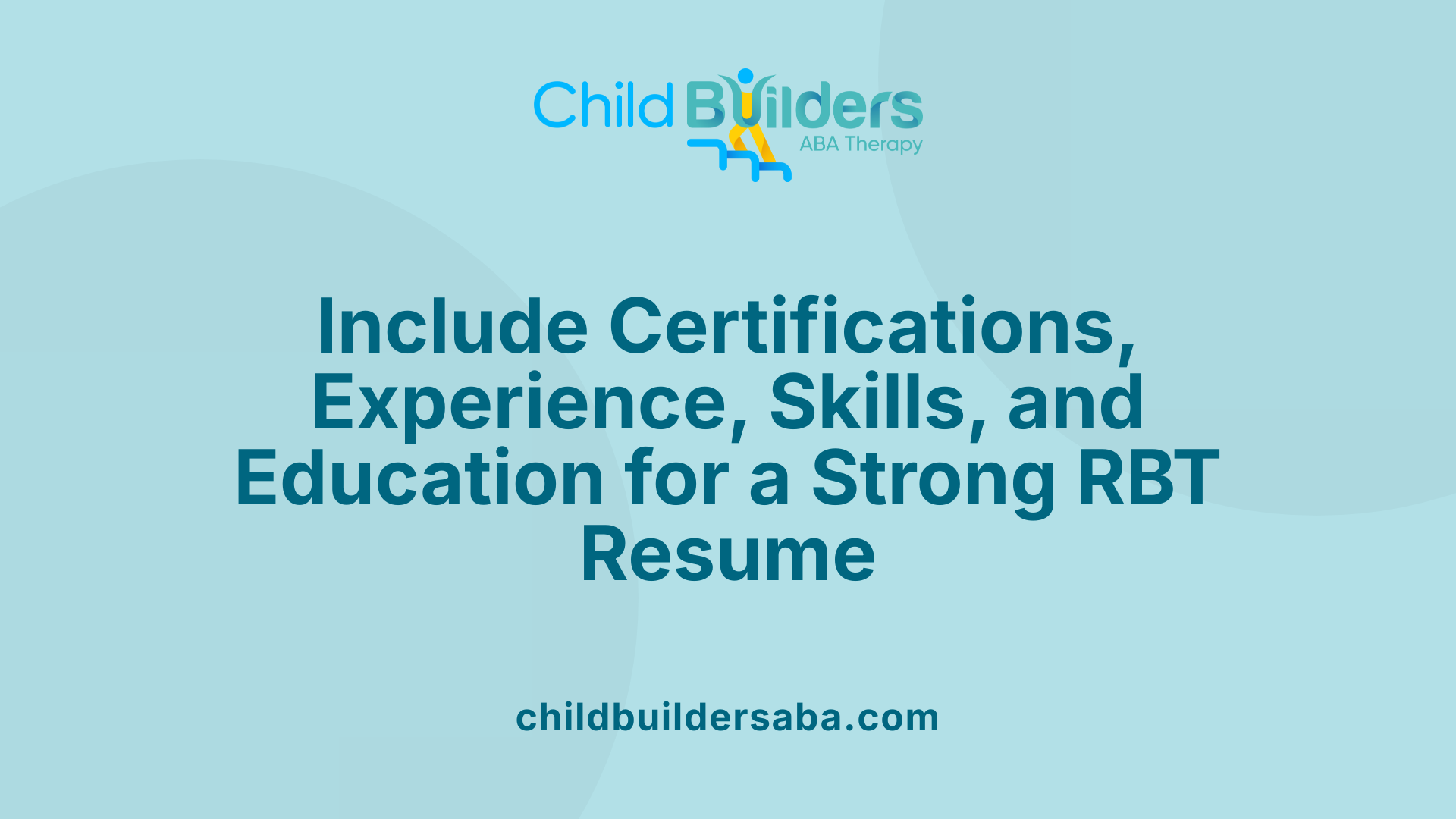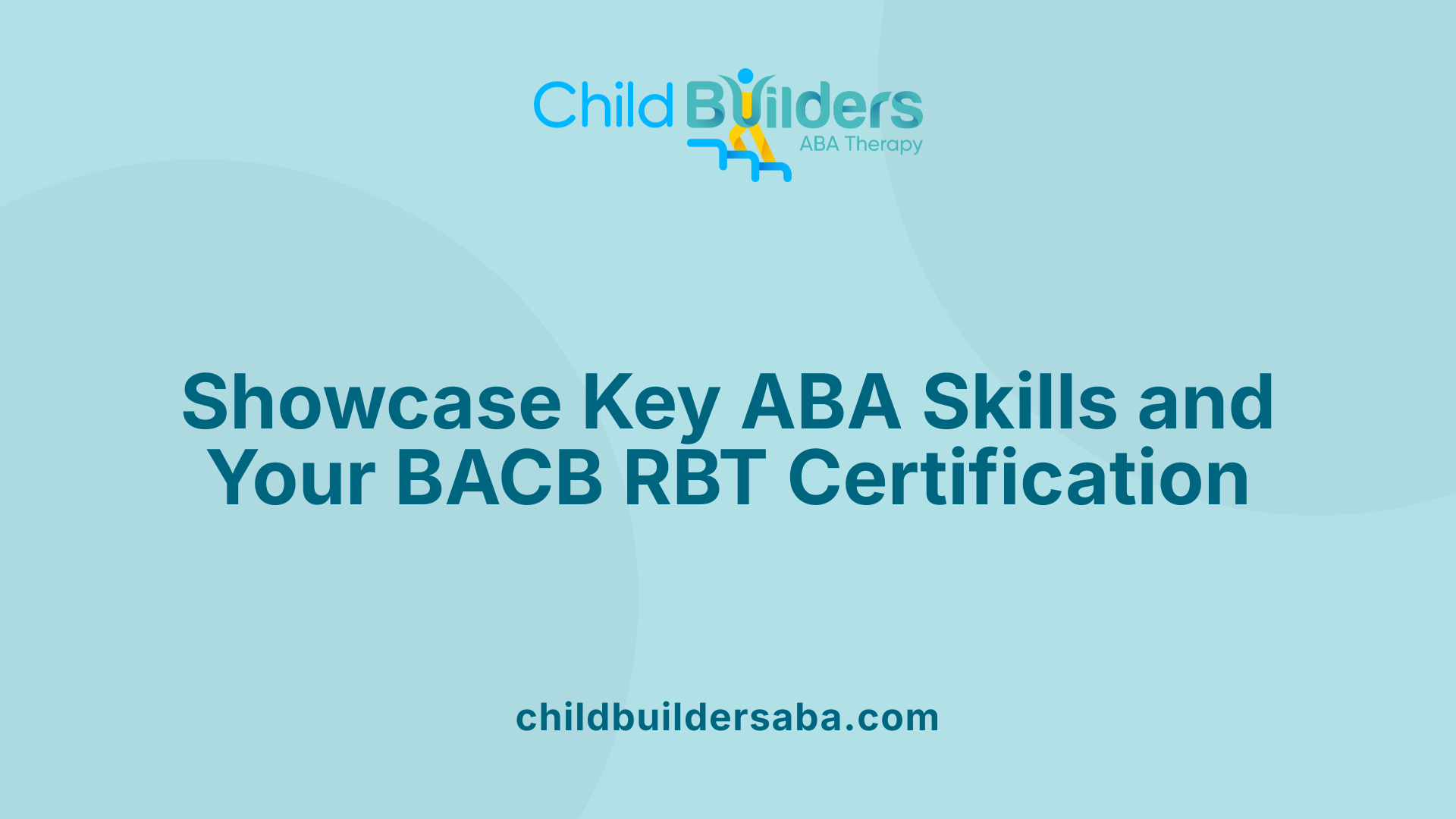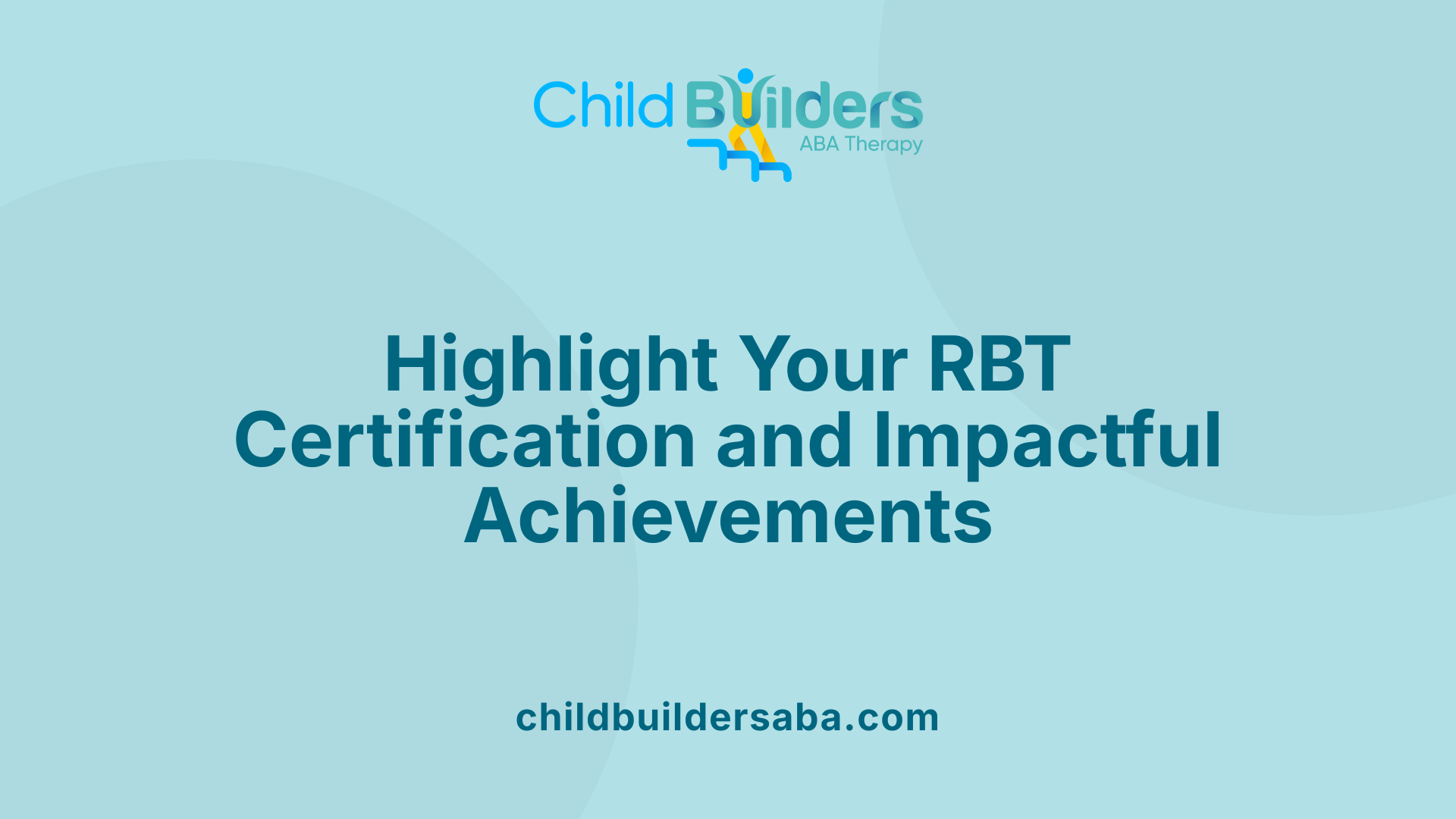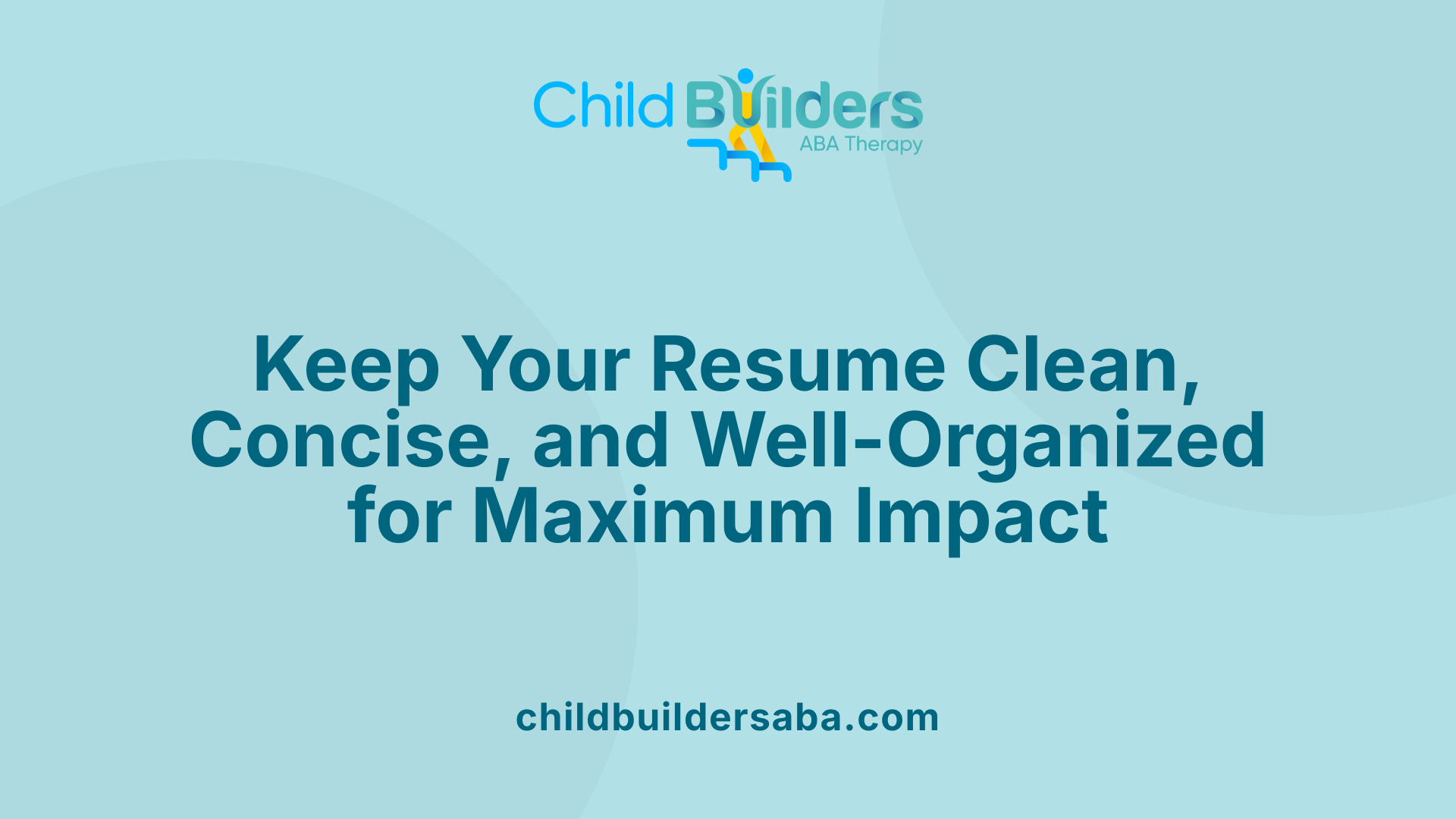RBT Resume

Your Guide to a Professional and Effective Registered Behavior Technician Resume
Developing a compelling RBT resume is essential for standing out in the competitive field of applied behavior analysis. A well-organized, targeted resume showcasing your credentials, experience, and skills can open doors to rewarding opportunities working with individuals with autism spectrum disorder and other developmental disabilities. This comprehensive guide explores best practices, key sections, essential skills, and formatting tips to help you craft a resume that captures the attention of hiring managers and aligns with industry standards.
Best Practices and Tips for Writing an RBT Resume
What are some best practices and tips for writing an effective Registered Behavior Technician (RBT) resume?
Crafting a compelling RBT resume involves a strategic approach that highlights your qualifications and experience clearly and effectively. First, it’s essential to prominently display your certification details. Include the name of the certifying organization, the certification number, and the expiration date to establish your credentials upfront. If you have undertaken additional training related to behavior analysis, such as courses in crisis intervention or specialized ABA techniques, mention these as well.
In your work experience section, focus on your hands-on involvement with ABA techniques like Discrete Trial Training (DTT), Natural Environment Teaching (NET), or Functional Communication Training (FCT). Describe your responsibilities using active language, such as "implemented behavior intervention plans" or "collected and analyzed data to monitor client progress."
Quantify your achievements wherever possible. For example, mention the number of clients you've served, behavioral improvements observed (like a 30% reduction in problem behaviors), or caseload management. These metrics help employers understand your direct impact and your capacity to handle multiple cases.
Collaboration skills are crucial for RBTs. Highlight your experience working alongside Board Certified Behavior Analysts (BCBAs), families, teachers, and other professionals. Illustrate your role in team meetings, providing reports, or supporting training and supervision.
Tailoring your resume for each specific role will improve your chances of success. Incorporate industry-specific keywords like "behavior reduction," "data collection," "behavioral assessments," or "client care" that align with the job description. Use a clear, chronological format that presents your most recent experience first.
Active language paired with a clean, organized layout enhances readability. Bullet points help break down complex information, making your skills and achievements stand out. Keep the document concise—ideally one page—so employers can quickly assess your fit.
Finally, don’t forget to include sections for certifications, ongoing professional development, and volunteer experiences, especially if they relate to behavioral health. Whether you’re just starting or have years of experience, these details demonstrate your dedication and continued growth within the field of ABA.
By adhering to these best practices, you’ll craft an RBT resume that captures attention, demonstrates your expertise, and positions you as a strong candidate for roles in behavioral health services.
Key Sections and Content of an RBT Resume

What key sections and content should I include in an RBT resume?
Creating a compelling resume as a Registered Behavior Technician (RBT) involves including several critical sections that collectively showcase your qualifications, experience, and commitment to the field. These components help demonstrate your ability to perform the job effectively and align your skills with employer expectations.
Professional Summary Begin your resume with a concise overview highlighting your experience working with diverse client populations, your certification credentials, and notable achievements. For example, mention your experience implementing ABA techniques such as Discrete Trial Training (DTT), Natural Environment Teaching (NET), and Functional Communication Training (FCT). Emphasize your success in reducing problematic behaviors and improving client outcomes, supported by measurable results.
Skills Section Include a dedicated skills section that emphasizes your familiarity with ABA methodologies, data collection, and analysis. Use industry-specific keywords like:
| Skill | Description | Example |
|---|---|---|
| DTT (Discrete Trial Training) | Structured teaching method for skill acquisition | Developed individualized DTT programs for children with ASD |
| Data Collection & Analysis | Recording and interpreting behavior data | Collected and analyzed data to track progress, leading to therapy adjustments |
| Natural Environment Teaching (NET) | Teaching skills in natural settings | Implemented NET strategies during community outings |
| FCT (Functional Communication Training) | Teaching functional communication | Reduced tantrums by teaching functional communication skills |
| Client Care & Support | Providing empathetic, professional support | Maintained positive rapport with clients and families |
Work Experience Detail your previous roles by listing your most recent position first. Focus on describing your responsibilities with active language and include quantifiable achievements.
- Managed a caseload of up to 10 clients, designing and executing behavioral interventions based on individualized plans.
- Implemented ABA techniques like DTT and NET, leading to an average of 30% improvement in client behaviors.
- Collected and analyzed data daily, providing reports to supervising BCBAs that informed treatment modifications.
- Collaborated with families and multidisciplinary teams to ensure consistency of interventions across environments.
- Supported clients across various settings, including homes, schools, and community programs.
Certifications and Ongoing Education List your credential with the BACB, such as the RBT certification, along with any additional relevant training.
- RBT Certification, BACB — Passed competency assessment and exam
- First Aid & CPR Certified
- Ongoing workshops on crisis prevention and intervention
Educational Background Include your academic qualifications related to psychology, behavioral sciences, or related fields.
- Bachelor of Science in Psychology | University of XYZ | 2021
- Coursework: Behavioral Analysis, Developmental Psychology, Special Education
Additional Sections If applicable, add sections like volunteer work, internships, or professional development activities that demonstrate your commitment and continuous learning.
- Volunteer Tutor for children with ASD at Local Community Center
- Intern at XYZ Behavioral Clinic, assisting with data collection and client support
Proper organization and formatting are crucial. Keep your resume to about one page, use bullet points for clarity, and tailor your language to match the job description, incorporating industry-specific terminology.
In summary, an effective RBT resume should feature a well-balanced presentation of your direct experience, technical skills, certifications, and educational background, framed within a clear, professional layout. Highlight your measurable successes, and ensure your resume actively demonstrates your readiness to support clients and collaborate within a team.
Essential Skills, Certifications, and Qualifications for RBTs

What skills, certifications, and qualifications are important to include on an RBT resume?
Creating a compelling RBT resume involves showcasing a mix of professional certifications, technical skills, and interpersonal abilities. First and foremost, candidates should list their current BACB certification as an RBT, including the certification number and expiration date. This certification verifies that the candidate has met all the prerequisites and competencies required by the Behavior Analyst Certification Board.
In addition to the primary RBT credential, including supplementary certifications like First Aid and CPR can be advantageous, demonstrating a commitment to safety and client well-being.
Technical skills are fundamental to the role. Candidates should clearly highlight their experience with data collection and analysis, particularly using industry-standard behavior tracking software such as CentralReach or Catalyst. Skills in designing and implementing behavior intervention plans, along with application of ABA techniques such as trigger identification, reinforcement strategies, and behavior reduction, are essential.
Soft skills also significantly impact job performance. Effective communication, compassion, teamwork, and active client care are highly valued. Demonstrating experience managing caseloads, tracking client progress, and applying behavioral analysis techniques to facilitate positive outcomes adds depth to the resume.
Educational background in psychology, behavior analysis, or related fields can strengthen your profile but is not mandatory. However, familiarity with compliance standards like HIPAA for privacy and IDEA for educational rights further supports a candidate’s qualification.
Including detailed experience with behavior analysis, managing diverse client populations, and prior success stories with measurable outcomes can significantly enhance the resume. For example, noting specific achievements such as "Reduced problem behaviors by an average of 30% over three months" provides concrete evidence of impact.
In summary, a well-rounded RBT resume should feature:
| Certification & Training | Technical Skills | Soft Skills | Experience & Outcomes |
|---|---|---|---|
| Current BACB RBT credential (number, expiry) | Data collection & analysis | Communication & Compassion | Caseload management & positive client outcomes |
| First Aid & CPR certifications | Behavior tracking software (e.g., CentralReach) | Teamwork & Client Care | Implementation of ABA techniques |
| Additional behavioral certifications | Behavior intervention plan implementation | Adaptability & Problem-solving | Reduction in problem behaviors measurable data |
| Knowledge of HIPAA & IDEA | Crisis prevention & intervention | Empathy & Active listening | Successful collaboration with BCBAs and families |
This comprehensive approach ensures that your resume convincingly portrays your qualifications, skills, and readiness for an RBT role, making you a strong candidate in the competitive behavior technician landscape.
Describing Experience and Qualifications Effectively

How should I describe my experience and qualifications as an RBT on my resume?
To make your resume stand out, it's important to clearly showcase your certification details. Include your RBT certification number and its expiration date prominently in the certifications section. This immediately demonstrates your verified credentials.
Highlight your practical experience with ABA techniques. For example, mention specific approaches like Discrete Trial Training (DTT), Natural Environment Teaching (NET), and Functional Communication Training (FCT). Describe how you adapted these techniques to meet the diverse needs of clients, which emphasizes your flexibility and expertise.
Quantify your achievements to give employers a clear picture of your impact. For instance, state that you reduced problematic behaviors by a certain percentage or helped clients reach specific developmental milestones. These metrics prove your effectiveness and contributions.
Your experience with data collection and progress monitoring should also be detailed. Explain how you tracked behavioral data, created progress reports, and collaborated with supervising BCBAs, families, and other team members to ensure consistent and effective intervention.
Don't forget to include relevant coursework, such as Applied Behavior Analysis classes, and additional credentials like CPR or First Aid certifications. Mention your proficiency in ABA data software tools, whether spreadsheets, specialized applications, or telehealth platforms, to demonstrate technical skills.
Use strong action verbs like "implemented," "monitored," "collaborated," and industry-specific terms like "behavior intervention plans" and "data analysis" to convey your active role.
Lastly, consider adding a professional summary at the top of your resume. Focus on your impact, such as "Dedicated RBT with proven success in reducing behavioral challenges and improving client engagement through tailored ABA interventions." This brief statement catches the recruiter's attention and sets the tone for your detailed experience.
In summary, a well-crafted RBT resume balances certifications, detailed experience, quantifiable achievements, technical skills, and a compelling professional summary to effectively showcase your qualifications and make a lasting impression.
Recommended Resume Templates and Examples for RBTs
There are many online resources offering tailored resume templates and examples specifically designed for Registered Behavior Technicians (RBTs). These templates serve as a valuable starting point, helping job seekers craft clear and compelling resumes that highlight their qualifications.
One reputable source is ResumeWorded, which provides detailed RBT resume examples that cover all essential sections. These include contact information, professional summaries, work experience, skills, education, and certifications like BACB RBT certification.
Using these templates, applicants can learn how to create impactful headlines that immediately convey their expertise and suitability for the role. For example, a strong headline might read, "Certified RBT with 3+ Years of Experience in Autism Support and Data-Driven Behavior Analysis."
Highlighting measurable achievements is crucial. Instead of simply listing duties, candidates should include quantifiable results. For instance, "Implemented behavior intervention plans resulting in a 30% reduction in problem behaviors over six months" demonstrates impact and competency.
Key skills relevant to RBT roles should be prominently featured. These include skills like ABA techniques, data collection, behavior management, client collaboration, and reporting. Incorporating industry-specific keywords not only aligns with ATS (Applicant Tracking Systems) but also shows familiarity with core responsibilities.
Many templates are customizable, allowing applicants to adapt them for different experience levels—be it entry-level or seasoned professionals—and various work environments such as clinics, schools, or home-based settings.
Utilizing these examples and tips enhances a candidate’s chance of standing out. An effective resume clearly articulates credentials, experience, and skills with a clean layout, consistent formatting, and concise bullet points. Keeping the resume to approximately one page ensures clarity and focus.
In summary, leveraging reputable sample resumes and templates can streamline the application process. They serve as practical guides for illustrating professional achievements, showcasing relevant skills, and presenting credentials compellingly, thereby increasing employment prospects within the ABA community.
Showcasing Experience and Skills Effectively

How can I showcase my experience and skills effectively on my RBT resume?
To craft a compelling RBT resume, it’s essential to highlight your abilities and background in a clear, structured manner. Begin by creating a dedicated skills section that emphasizes relevant competencies such as ABA techniques, data collection, behavior analysis, and soft skills like communication and teamwork.
In this section, include industry-specific keywords and action verbs to demonstrate your expertise actively. For example, terms like "implemented behavior intervention plans," "collected and analyzed client data," or "collaborated with multidisciplinary teams" help catch the eye of hiring managers and applicant tracking systems.
Your certification details should also be prominently displayed. Include your BACB RBT certification number, expiration date, and relevant training courses, such as crisis prevention or autism-specific certifications, to establish credibility.
Detail your professional experience with a focus on the diverse client populations you've worked with. For each role, specify the interventions employed—such as Discrete Trial Training (DTT), Natural Environment Teaching (NET), or Functional Communication Training (FCT)—and describe how your work contributed to client progress.
Quantify your achievements to provide concrete evidence of your impact. For instance, mention serving a specific number of clients, reducing problematic behaviors by a certain percentage, or improving communication skills measurable through client progress reports.
Teamwork plays a vital role in behavior therapy. Highlight your collaborations with Board Certified Behavior Analysts (BCBAs), families, and other team members, illustrating your ability to work in multidisciplinary environments.
Ensure your resume is well-organized, with consistent formatting and a professional appearance. Tailor each resume to the specific job description by emphasizing relevant skills and experiences, making your application stand out.
Below is a sample breakdown of how to present your information:
| Section | Content | Details |
|---|---|---|
| Skills | ABA Techniques, Data Analysis, Client Care, Behavior Reduction, Communication | Bullet points listing core skills with industry keywords |
| Experience | RBT at XYZ Clinic | Managed caseloads of 5-10 clients, implemented behavior plans, reduced problematic behaviors by 30%, collaborated with BCBAs and families |
| Certifications | BACB RBT Certification | Certified in 2022, active until 2024, completed crisis prevention training |
This structured approach ensures your resume showcases your qualifications effectively and optimization for the role.
Understanding the Significance of an RBT Credential on Your Resume
What is the significance of being an RBT on a resume?
Including the RBT (Registered Behavior Technician) credential on your resume is an important step in demonstrating your qualifications in the field of applied behavior analysis (ABA). This certification indicates that you have received specialized training focused on implementing ABA techniques to assist individuals, often with autism spectrum disorder (ASD).
Employers highly value the RBT credential because it confirms your hands-on experience with behavioral interventions, data collection, and supporting clients across various environments. It shows you are committed to professional growth and have met the rigorous standards set by the Behavior Analyst Certification Board (BACB).
Detailing your certification date and expiry can further enhance your profile’s credibility, signaling your active engagement in your professional development. Your resume should highlight whether your experience covers different client populations, such as children or adults, and if you have worked in early intervention or clinical settings.
This credential sets you apart from other candidates who might only list general experience or education. It also allows you to include industry-specific keywords, increasing your visibility in applicant tracking systems.
For example, listing your RBT certification under a dedicated Certifications section—alongside relevant coursework, ongoing training, or relevant skills like data analysis—can make a strong impact. This demonstrates your readiness to support behavioral health teams and contributes to your chances of landing interviews.
In an increasingly competitive job market, showcasing your RBT credentials can significantly enhance your professional profile. It signals to employers not only your certification status but also your dedication to advancing in the rapidly growing field of ABA therapy.
Addressing Common Questions and Misconceptions in RBT Resume Writing
How do you showcase relevant skills and experience with limited background?
Many individuals new to the RBT role worry about their limited professional experience. The solution is to emphasize transferable skills such as excellent communication, patience, data collection abilities, and familiarity with ABA techniques. Including volunteer work or internships related to behavior analysis can also bolster your experience. Highlight any hands-on practice with data collection or behavior intervention, even if informal, to demonstrate practical knowledge.
Should I focus more on certifications or work experience?
For aspiring RBTs, certifications such as the BACB Registered Behavior Technician credential are crucial. They validate your knowledge and commitment to ethical standards. While work experience is valuable, especially roles involving client care or behavior management, certifications often carry more weight initially. Emphasize your certification status, passing the competency assessment, and any relevant training courses you've completed.
How important are measurable achievements and quantifying successes?
Including metrics on your resume provides concrete evidence of your capabilities. For example, you might detail how you increased a client’s compliance rate by 20% through behavior intervention plans or reduced problematic behaviors by a specific percentage. Clearly quantifying your impact not only makes your resume stand out but also demonstrates your effectiveness as an RBT.
What resume format is best for ATS screening?
A clean, straightforward format ensures your resume gets through applicant tracking systems (ATS). Use standard headers like "Experience," "Education," and "Skills." Incorporate industry-specific keywords such as "ABA techniques," "data analysis," "behavior management," and "client care." Avoid complex layouts or graphics that might confuse ATS software. Bullet points should be concise and start with action verbs for clarity.
Are there misconceptions about what to include in an RBT resume?
A common misconception is that everything related to past jobs is necessary; in reality, relevance is more important. Focus on skills, certifications, and experiences directly related to behavior analysis. Don’t overload your resume with unrelated work history; instead, customize it for each role, emphasizing the most pertinent information.
Finally, remember to keep your resume well-organized and concise — ideally one page. Use active language, quantify achievements where possible, and tailor your content to match the specific requirements of each job posting. Doing so will help you craft a compelling RBT resume that effectively communicates your qualifications and enthusiasm for the role.
Formatting and Presentation Tips for RBT Resumes
 Creating a compelling resume as a Registered Behavior Technician (RBT) involves not only showcasing your relevant skills and experience but also ensuring the document is visually appealing and easy to read. A well-organized resume enhances your chances of landing an interview by making your qualifications stand out.
Creating a compelling resume as a Registered Behavior Technician (RBT) involves not only showcasing your relevant skills and experience but also ensuring the document is visually appealing and easy to read. A well-organized resume enhances your chances of landing an interview by making your qualifications stand out.
Begin with a clean, professional layout that uses consistent formatting throughout. Use clear section headings such as "Summary," "Work Experience," "Skills," "Certifications," and "Education." This logical flow guides the employer smoothly through your credentials.
Keep your resume concise—aim for about one page. This requires careful selection of information, focusing on the most relevant details. Incorporate bullet points to improve readability, making it easier for busy hiring managers to scan your achievements quickly.
Position the most critical information at the top of your resume. For example, feature a brief, impactful professional summary that highlights your certification, experience level, and specialty areas in ABA. Including industry-specific keywords, such as "behavior reduction," "data collection," or "ABA techniques," is vital to pass Applicant Tracking Systems (ATS) screenings.
Maintain a logical structure by using consistent font sizes, standard fonts like Arial or Calibri, and adequate spacing. This aesthetic consistency conveys professionalism and attention to detail.
When listing your experience, focus on quantifiable achievements—such as managing caseloads effectively, increasing compliance rates, or reducing problematic behaviors by specific percentages. Use active language like "implemented," "collaborated," and "obtained" to emphasize your proactive role.
In the skills section, include around seven to ten skills relevant to the RBT role. Typical skills might include client care, behavior analysis, data management, teamwork, and crisis prevention.
Remember, your certifications should be prominently displayed. List your BACB RBT certification, including certification date and expiration. Mention any additional training, such as autism training, crisis prevention, or specialized therapies, that support your role.
Finally, tailor your resume for each position by adjusting your experience and skills to match the specific job description. Use precise, industry-specific terminology to demonstrate your familiarity with the field.
In summary, a well-structured, clean, and targeted resume will effectively showcase your qualifications and increase your chances of securing an interview. For example, a sample resume might start with a professional summary emphasizing your RBT certification, followed by experience highlighted with measurable successes, and skills aligned with ABA best practices.
Final Tips for an Effective RBT Resume
In conclusion, crafting an effective RBT resume involves a strategic combination of clear organization, industry-specific keywords, quantifiable achievements, and authentic certifications. Ensure your resume accurately reflects your experience working with diverse client populations using ABA techniques, and highlight your ongoing professional development. Tailor each application to the specific role by emphasizing relevant skills and accomplishments, and keep the layout professional and concise. With these best practices in mind, you will improve your chances of standing out to potential employers and advancing your career in applied behavior analysis.
References
- RBT (Registered Behavior Technician) Resume Examples for 2025
- 7+ Registered Behavior Technician Resume Examples & Top Skills
- 12 Behavior Technician Resume Examples for 2025
- RBT Resume: Registered Behavior Tech Examples & Guide - Zety
- Creating an Effective RBT Resume - ABATherapistJobs.com
- RBT (Registered Behavior Technician) Resume Examples for 2025
- Registered Behavior Technician Resume Examples & Templates
- RBT (Registered Behavior Technician) Resume Examples for 2025
- 7+ Registered Behavior Technician Resume Examples & Top Skills
- Registered Behavior Technician Resume Examples & Templates



.jpg)

































































































